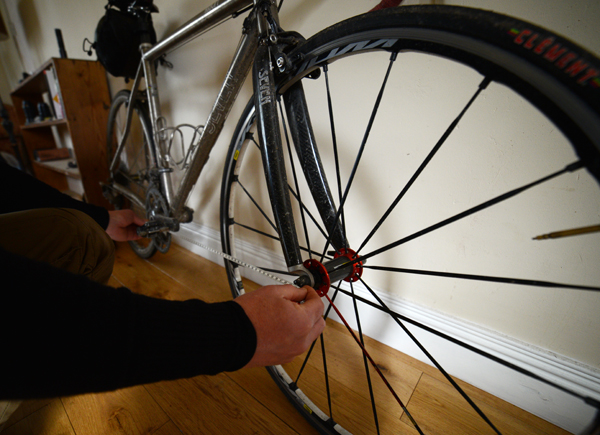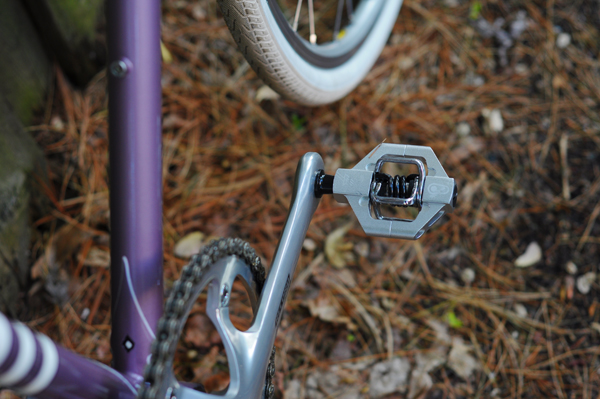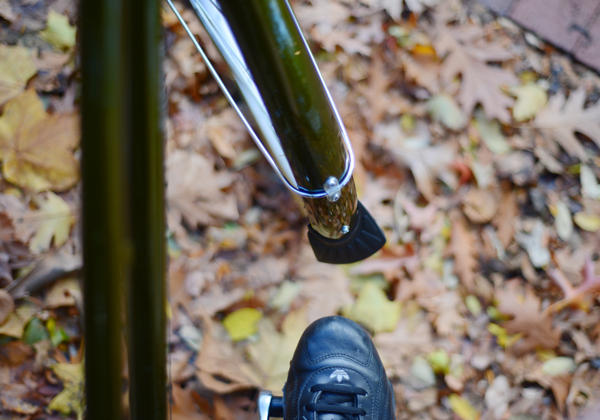
My intent is not to host another TCO debate, but to address this question for those who do want to avoid toe overlap. And the short answer is yes, TCO can be determined by a bicycle's frame geometry. The crucial measurement is what's known as the Front-Center - the distance from a bicycle's bottom bracket to the front axel (center to center), measured as shown in the picture above. Many manufacturers now provide this figure in the geometry specs. It is usually stated in millimeters.
Now, the key is to know what you need that figure to be in order for your toe to clear the front wheel. And this will depend on a number of things. Some of them will be specific to you, and will remain constant: the type and size of shoes you wear, and the way you position your foot on the pedal. Others will be specific to the type of bicycle you are getting: wheel size, tire size, and whether fenders will be used. To figure out your desired Front-Center figure, you will need to factor in all of these variables.
So let's start easy and say you are shopping for a new roadbike with 700C wheels and 23mm tires. Your current roadbike with the same wheel and tire size (that part is key) has a bit of toe overlap, and it's something you want to avoid in your new bike. So you measure your current bike's Front-Center and determine it to be 575mm. How much more room do you need for your toe to clear the tire? Well, put on your cycling shoes, clip in, and measure at the point of greatest overlap (by turning the wheel as if you are making a tight turn at slow speed). Maybe have someone else measure for you as well, to double check. And err on the conservative side just to be safe. 5mm of overlap? You sure? Okay, so this means that on a roadbike with 700C wheels and 23mm tires you need the Front-Center to be a minimum of 580mm.

If you plan to use wider tires, or fenders, or both, keep increasing that figure as appropriate. Because fender fit and true tire size differ from brand to brand, you will be estimating unless you have a chance to try a bike outfitted with the exact same tires and fenders your new bike will have. If you're cutting it close, consistency is key.
But what if you want to switch to a different wheel size? For instance, if you're shopping for a 650B x 42mm bike, and have no current basis for comparison? This is tricky, as you will basically need to calculate the difference between your current wheel + tire combination and that of the bike you're considering. But the numerical information for such calculations is freely available and, if you're mathematically inclined, figuring this out will be fun. And don't forget the fenders!
For a bike that will be ridden without clipless shoes (for instance, an upright city bicycle), toe overlap is more ambiguous. With your foot unattached, you'll be able to plop it onto the pedal every which way - which can result in the occasional fender bump even when there is plenty of clearance. There will also be greater variety in the footwear you will wear on the bike. On a given bicycle, you may have enough toe clearance when wearing sneakers and dress shoes, but find that you scrape the front fender on slow turns in clunky work boots.
So if you absolutely positively do not want any toe overlap what so ever on a non-clipless bike, be sure to wear your most toe-protrudingest shoes and to plop your foot as far forward on the pedal as you dare, when measuring for your desired Front-Center figure.
If you've determined your minimal Front-Center, but the geometry chart of the bicycle you're considering doesn't offer this information, you can always contact the manufacturer and ask. Just make sure you tell them the specific frame size you're looking at, because this measurement is size-specific. And if you are working with a framebuilder, you can of course simply tell them the Front-Center figure you need - or better yet, they can help you figure it out.
There is no substitute for trying a bike before buying. But if that is not an option, hopefully this has shed some light on how to ensure a TCO-free purchase.





0 comments:
Post a Comment